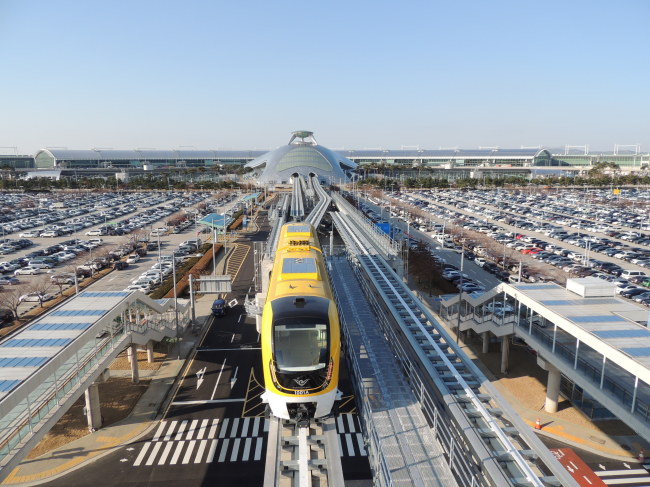South Korea's Incheon Transit Corp. began commercial operations of a magnetic levitation train made by Hyundai Rotem, the train-building affiliate of Hyundai Motor Group, on Wednesday.
It marks the second urban magnetic levitation train ever to be commercialized in the world, after Japan’s Nippon Sharyo launched its own service in Nagoya in 2005.
The unmanned train will carry passengers on a 6.1 kilometer route linking Incheon International Airport and Yongyu Station, a tourist location on the same island as the airport. The route is scheduled for future expansion.
 |
Hyundai Rotem’s self-developed magnetic levitation train begins operations at Incheon International Airport on Wednesday. (Hyundai Rotem) |
The maglev train will carry up to 230 passengers and run at a maximum speed of 80 kph, though it is designed to travel at a speed of up to 110 kph, according to the Transport Ministry.
Incheon Transit Corp. is operating the new service for free for now, as it is a pilot project. It will run from 9 a.m. to 6 p.m. with plans for extended operations and fee charging in the future.
Hyundai Rotem initially developed a maglev train with its own technology back in 2006, since which the government spent a total of 414.9 billion won ($342 million) on commercializing the train service for public use.
Free of wheels, magnetic levitation trains use a powerful magnetic field to suspend themselves above a track by about 8 millimeters, reducing noise, vibrations and steel dust compared to conventional trains.
Since it does not make any physical contact with the track, a maglev train is also able to accelerate, decelerate and turn corners with more ease.
The company said its maglev railway tracks were slimmer than their conventional counterparts, reducing construction costs. Maintenance costs are low as well because the components of maglevs take longer to wear out.
As the world’s second commercial maglev train operator, Hyundai Rotem plans to make efforts to supply maglev trains overseas, including in the U.S., Russia, Malaysia and Indonesia which have reportedly expressed their interest in the service.
“We plan to step up our efforts to further export our maglev train technology, which has been garnering much attention as an eco-friendly mode of transportation for the future,” said a Hyundai Rotem official.
The Transport Ministry said it planned to “offer diverse forms of administrative support” to promote the competitiveness of Korean maglev technology amid encroaching competition from China.
Industry watchers expect the overseas sales of Hyundai’s maglev trains to lend a hand in improving the sales of the struggling Hyundai affiliate, which recorded its worst annual performance to date last year due to an industry-wide slump.
The company recorded a net loss of 303.5 billion won ($252.5 million) and operating deficit of 192.9 billion won in 2015, prompting analysts to lower their ratings.
To revive profits, Hyundai Rotem has set forth key agendas for each of its business segments including plans to expand its railway system maintenance services, while partaking in heavy cost-cutting measures including asset sales, a voluntary redundancy program and wage cuts.
By Sohn Ji-young (
jys@heraldcorp.com)








![[Today’s K-pop] Blackpink’s Jennie, Lisa invited to Coachella as solo acts](http://res.heraldm.com/phpwas/restmb_idxmake.php?idx=644&simg=/content/image/2024/11/21/20241121050099_0.jpg)